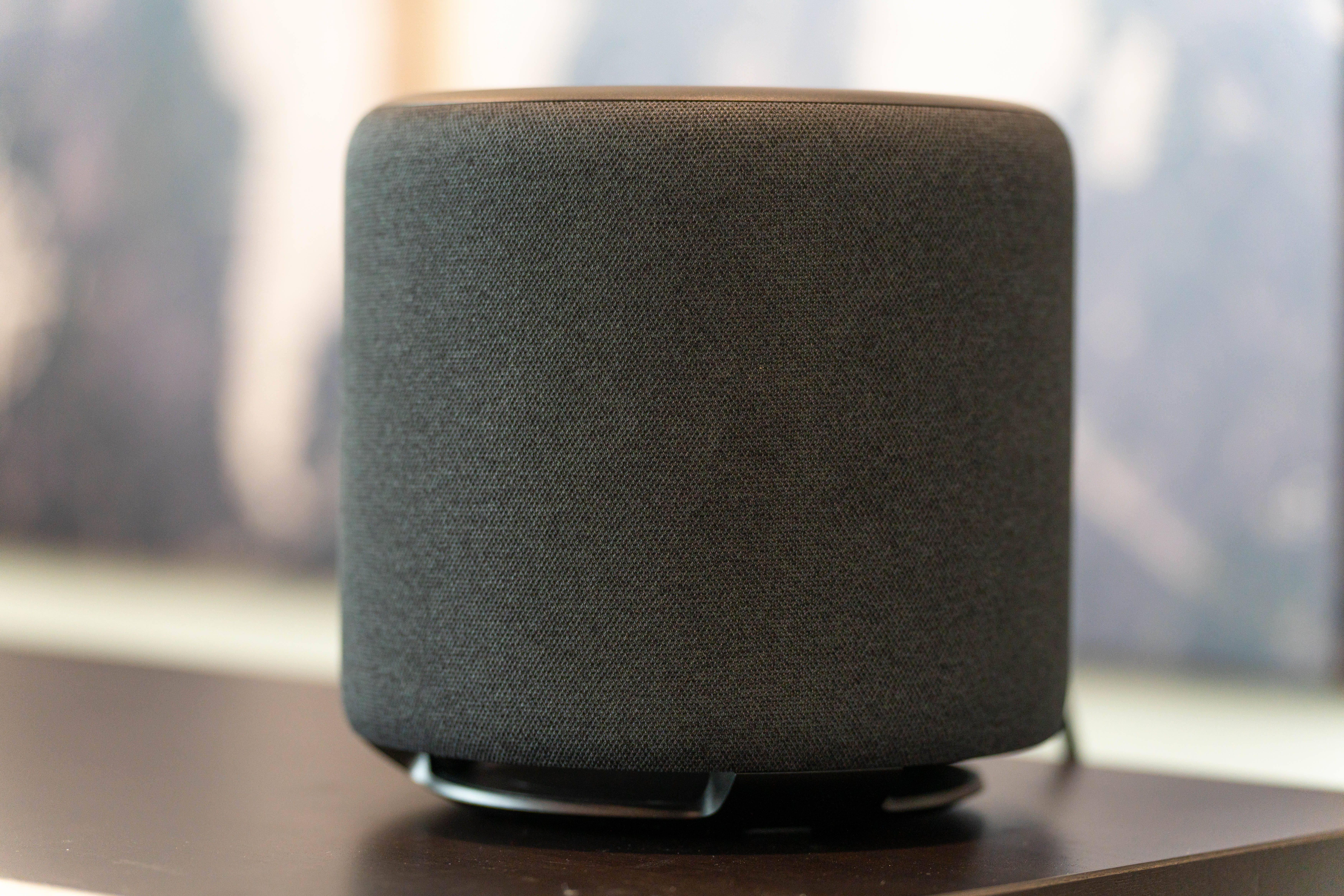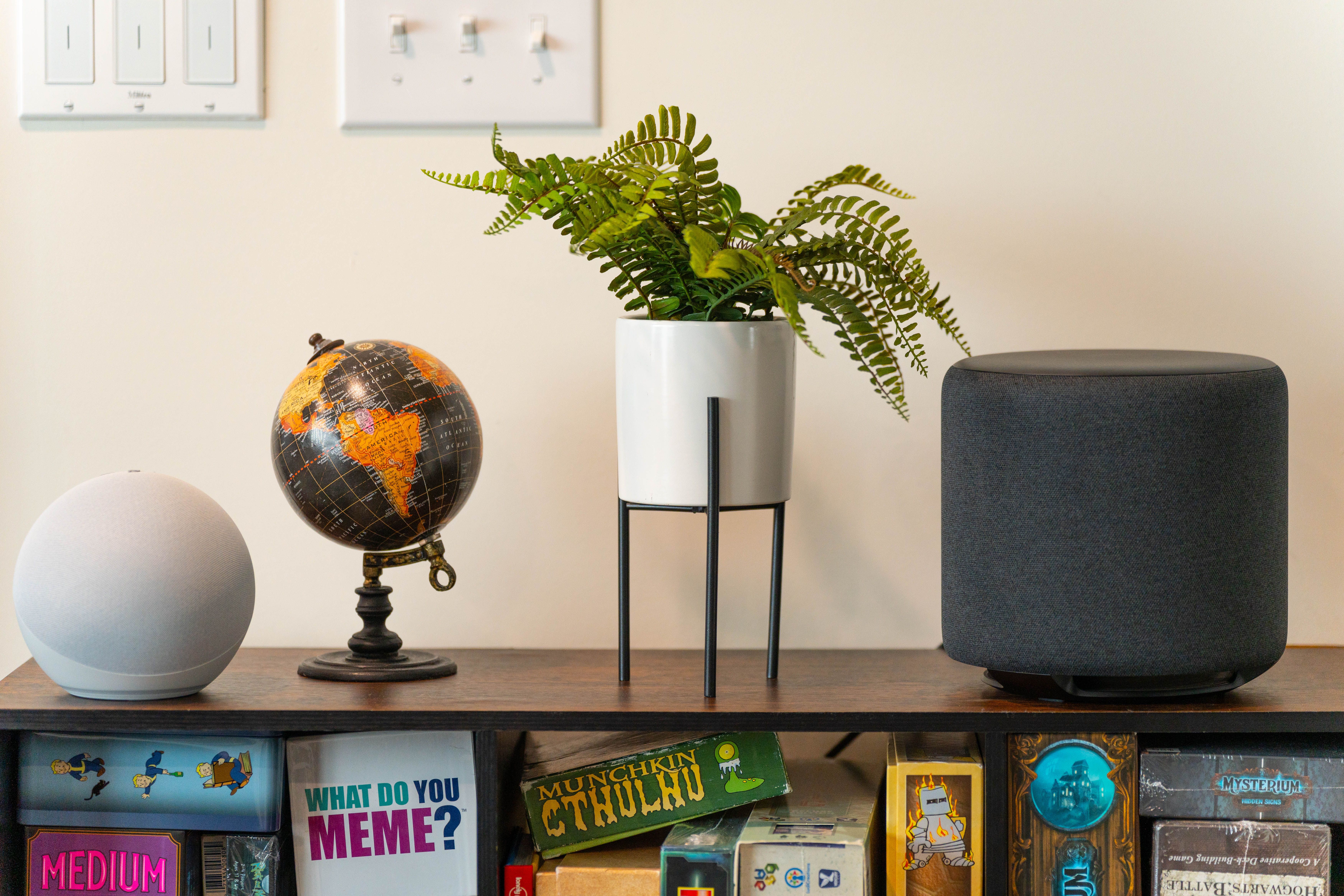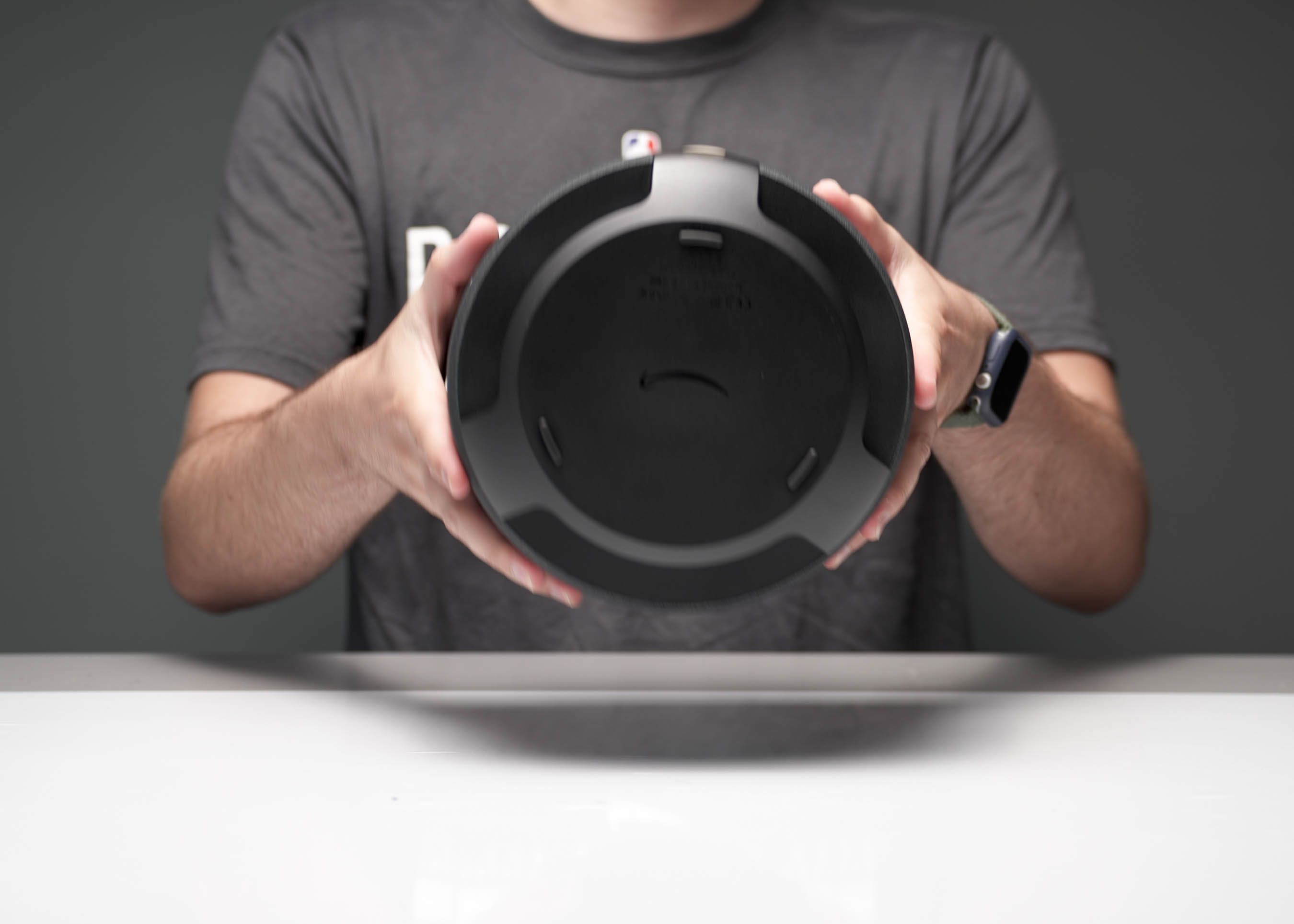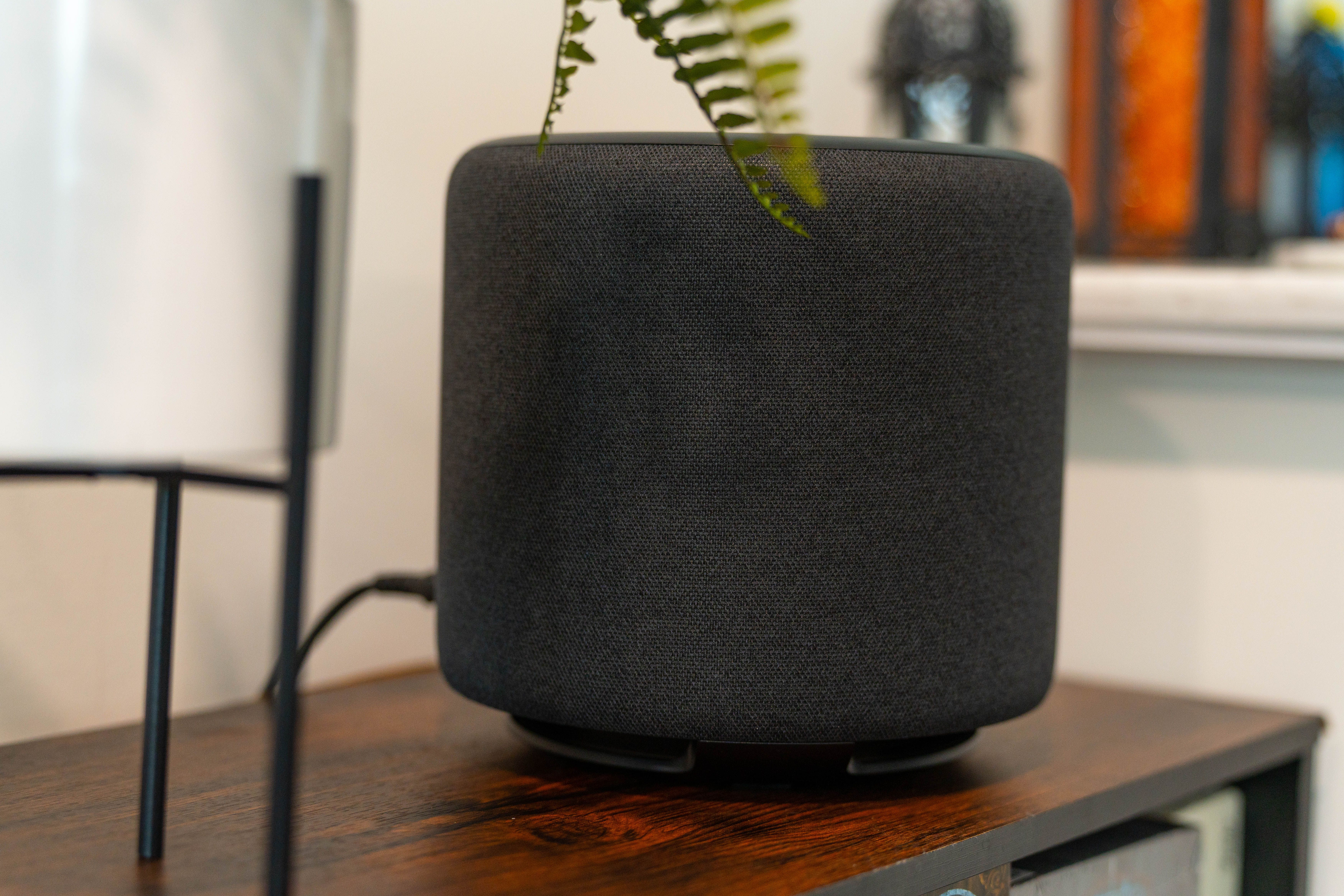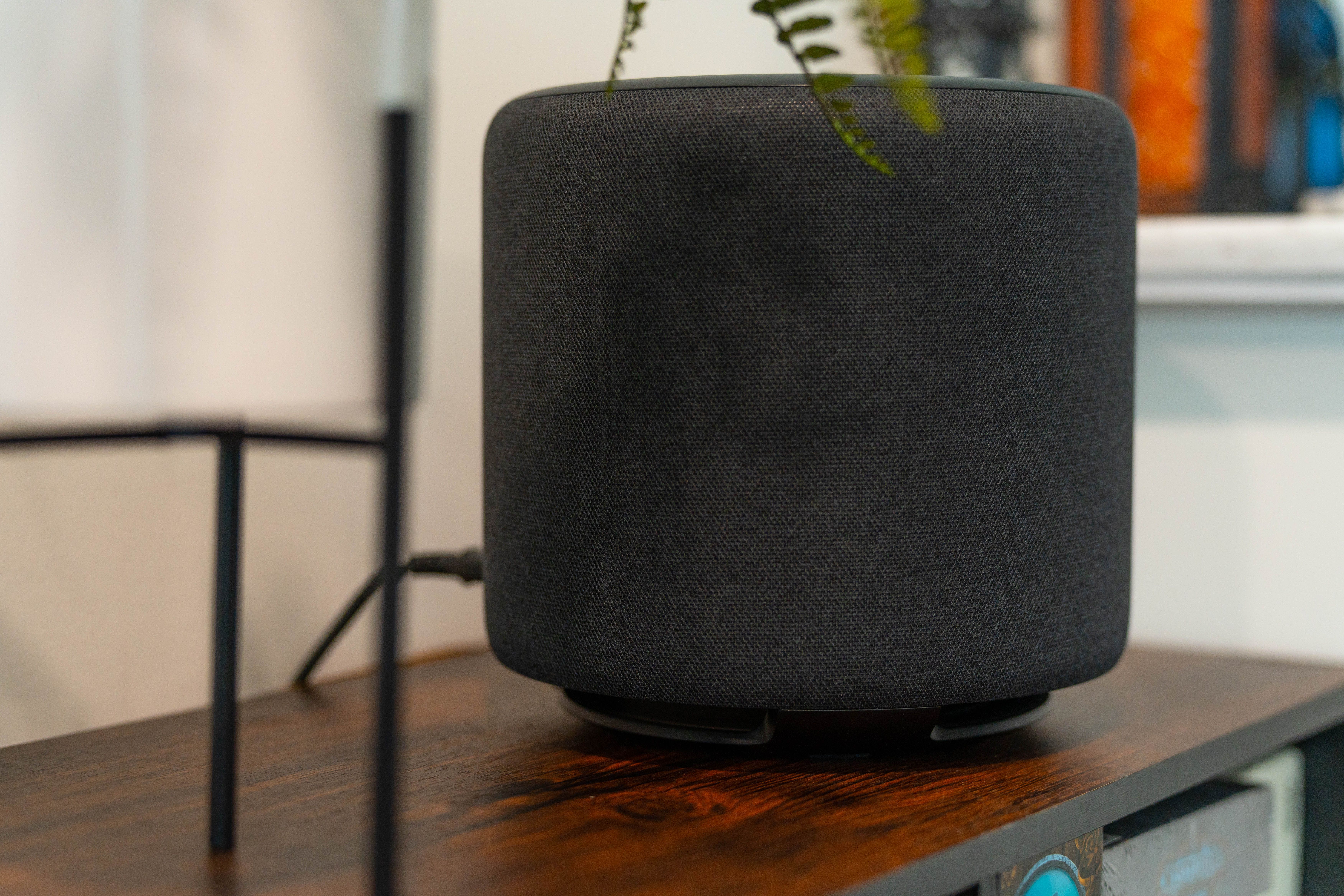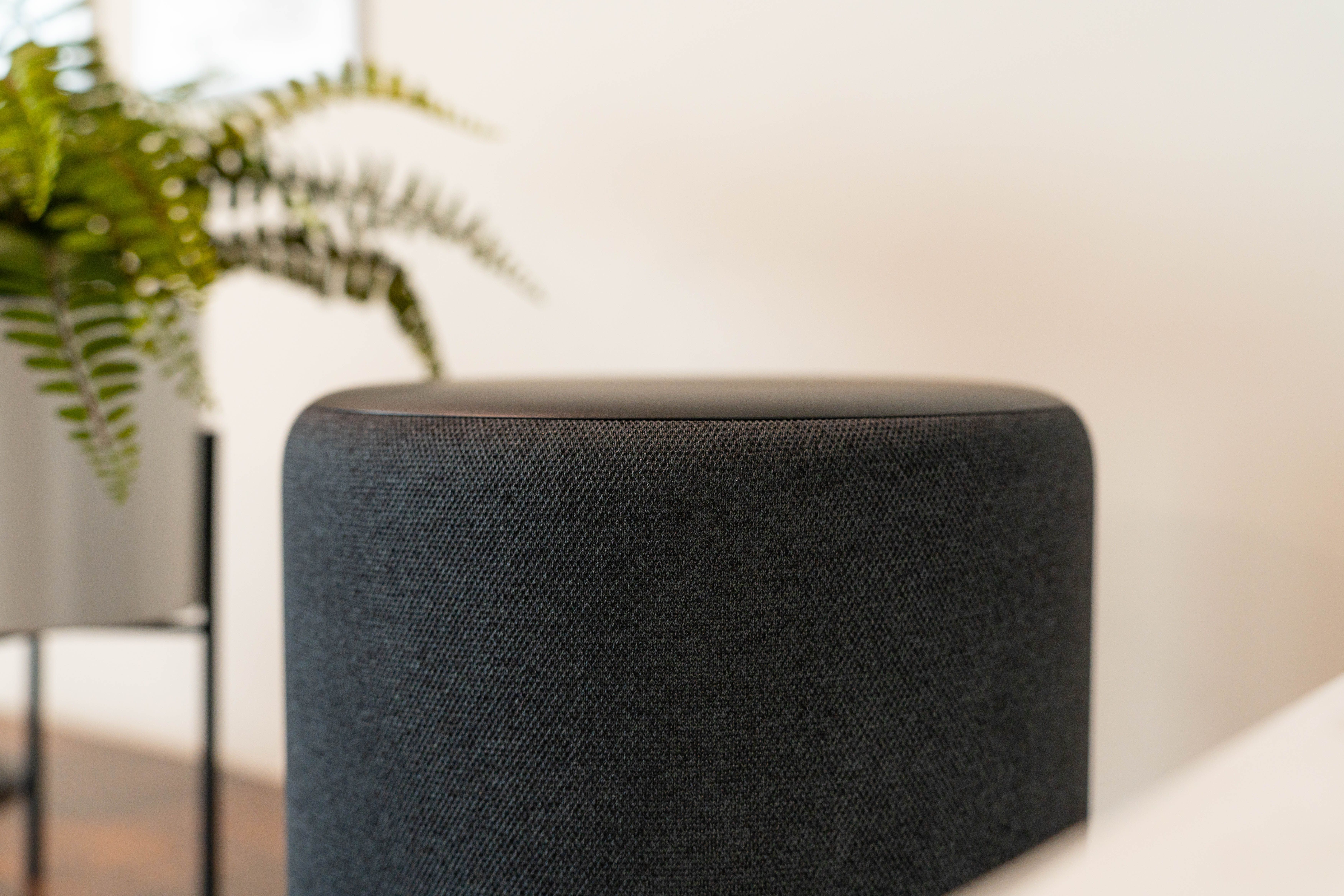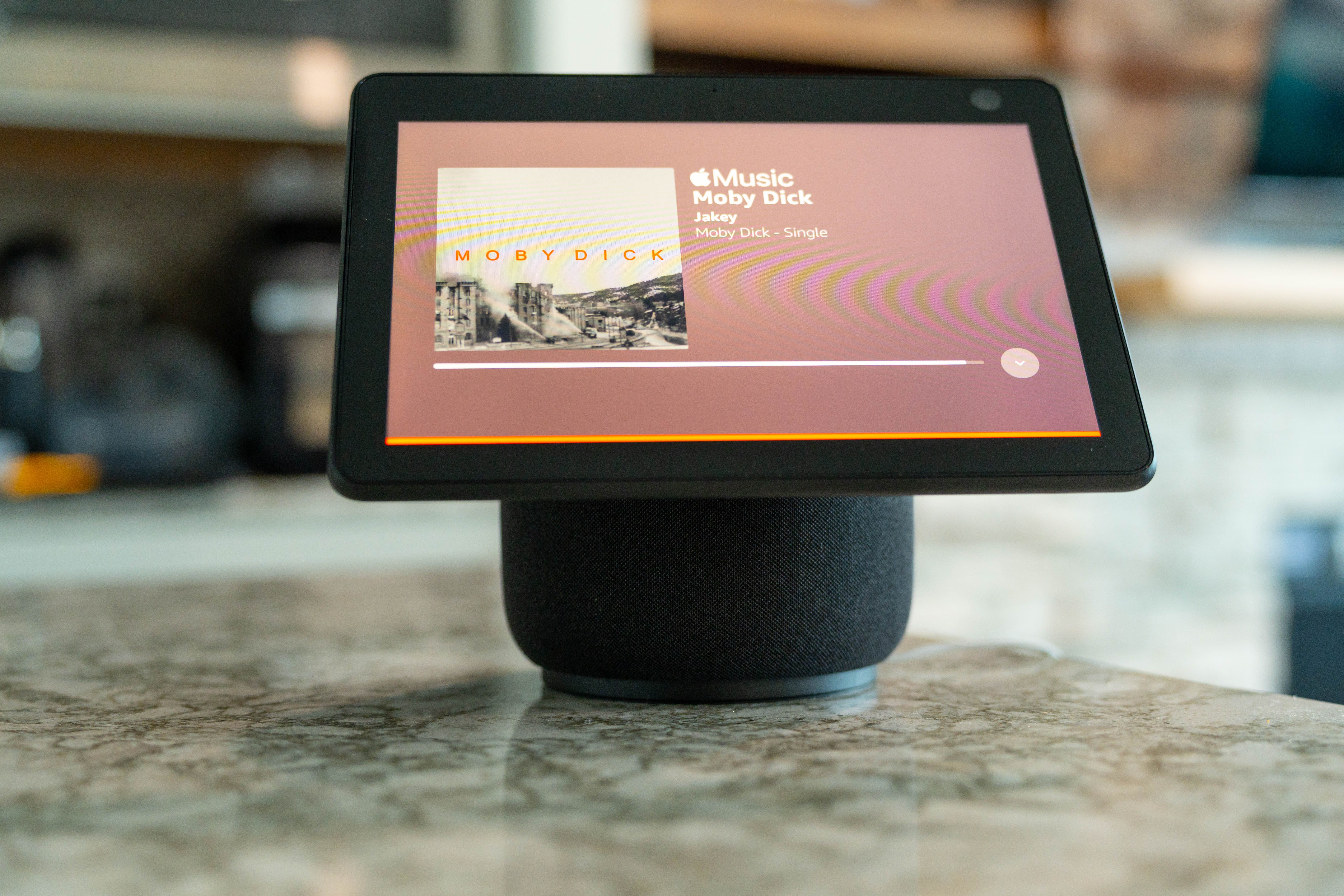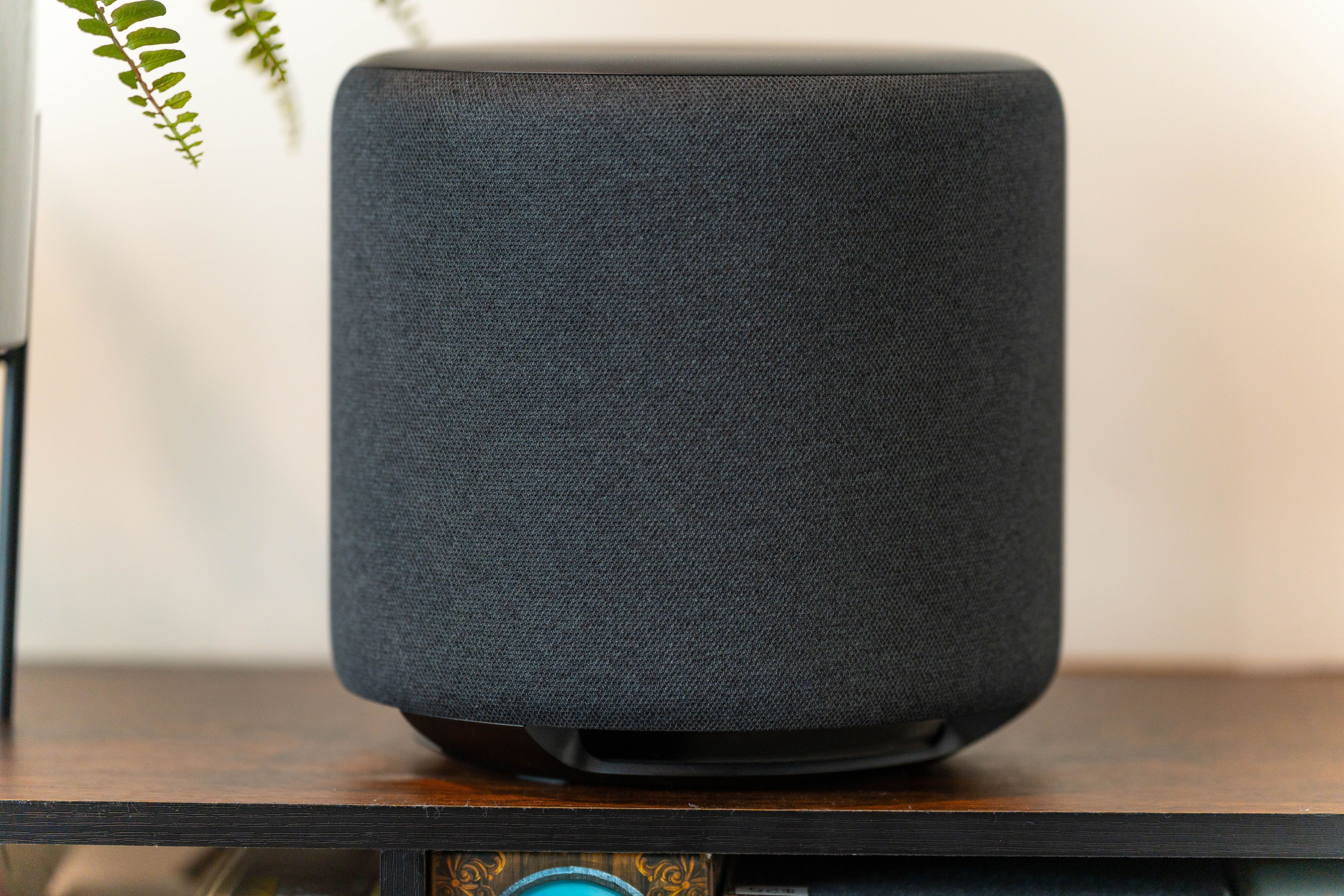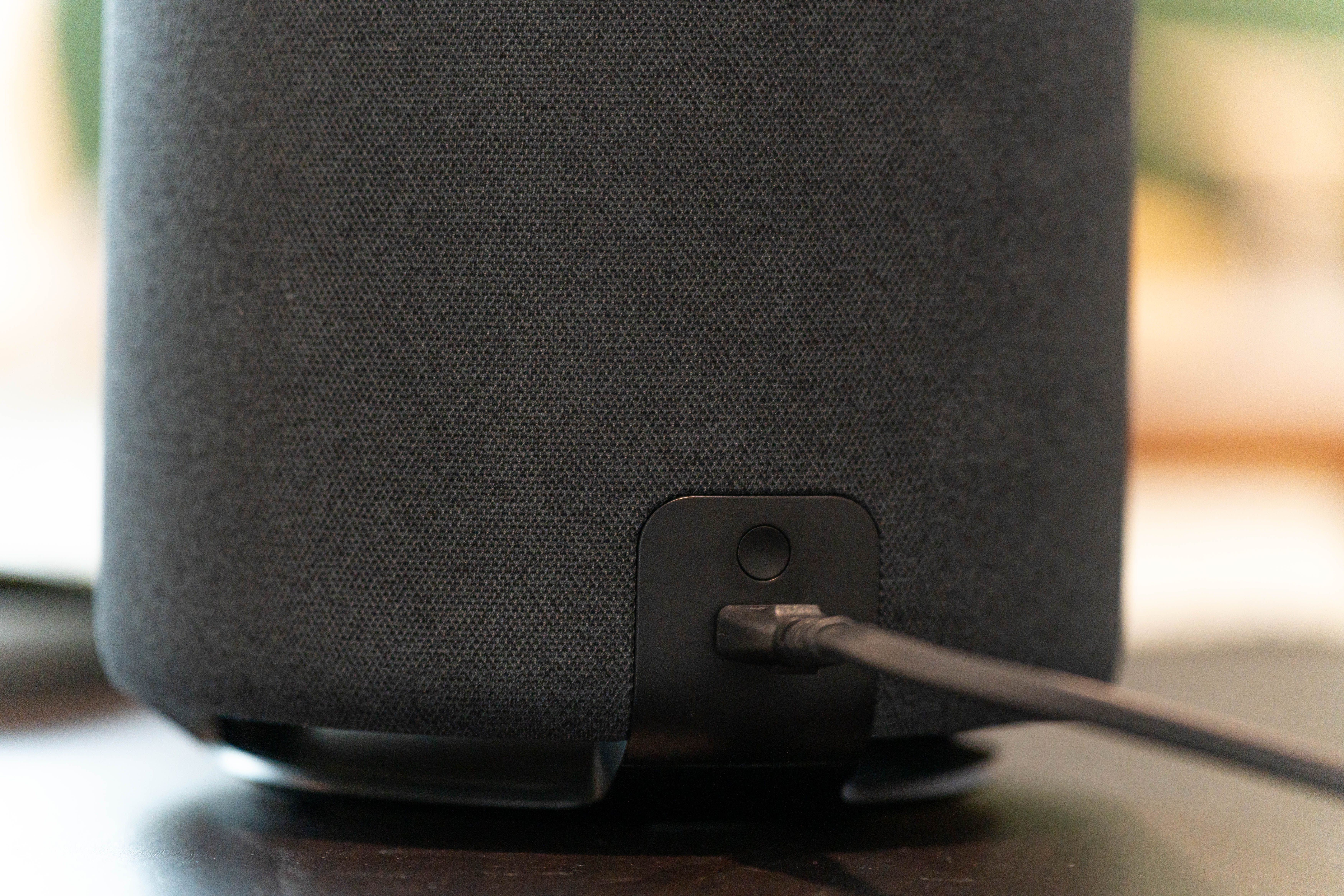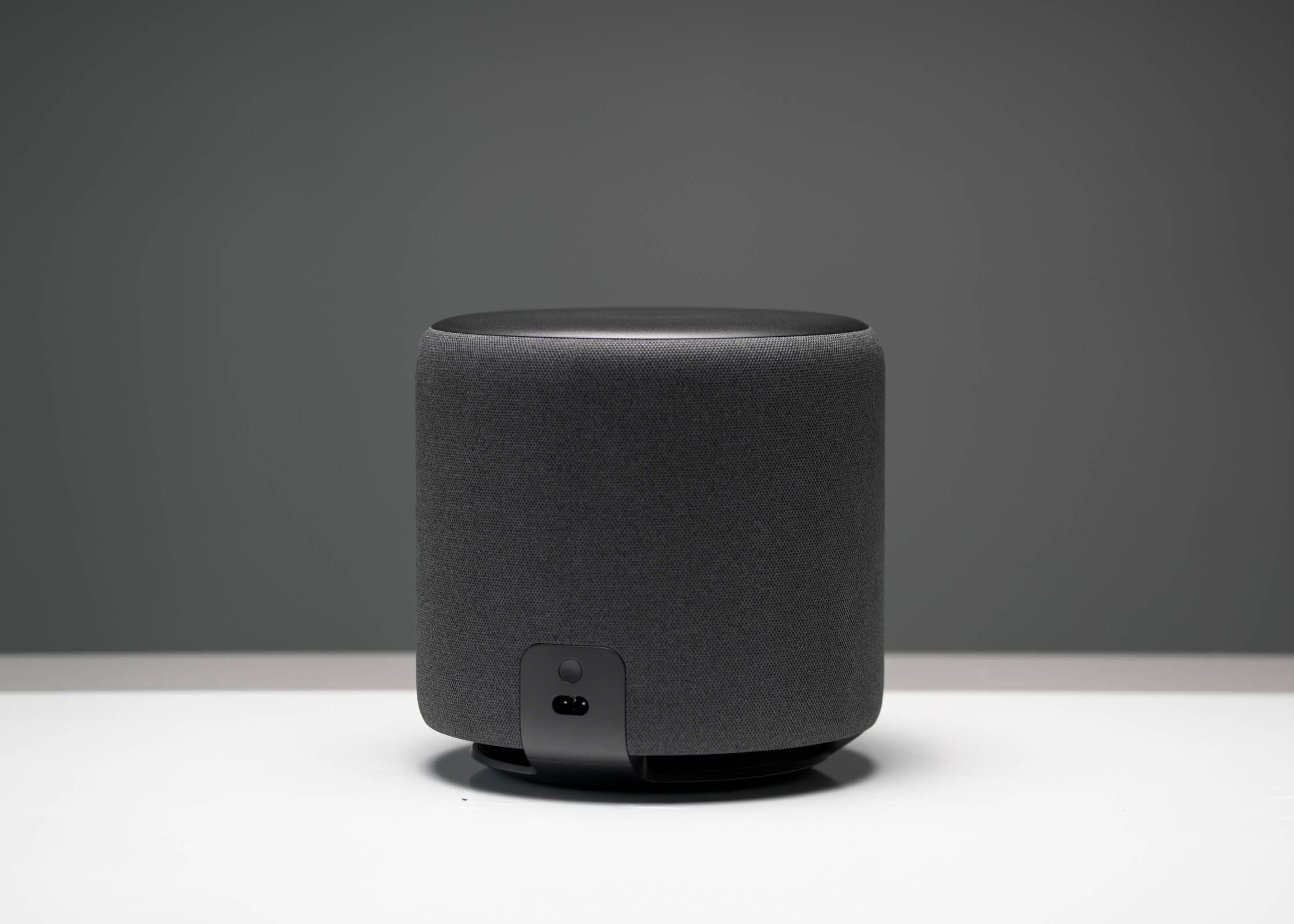Amazon Alexa Sub
As it stands, the Amazon Echo Sub is largely held back by limited software that makes the setup, pairing, and customization process unreliable and deceivingly complicated. With one of its biggest selling features being its simplicity to add to an existing Echo system, it misses its mark by a long shot. Wireless connectivity has its benefits, but Amazon has a lot of kinks to work out.
- Alexa Wireless Subwoofer
- Pairs with other Alexa Speakers
- Brand: Amazon
- Display: NA
- Dimensions: 8.3" x 8"
- Weight: 9.3lb
- Integrations: None; must be paired with another Echo device
- Woofer Size: 6"
- Crossover Frequency: 50 Hz - 200 Hz adaptive low-pass filter
- Audio: 4L sealed chamber with 6” (152 mm) downward-firing woofer, 100W Class D amplifier
- When paired and working properly, it can add some much needed bass to your Alexa setup
- Low-profile and much nicer looking than most wireless subs
- Potentially, a very simple setup process (when it works)
- Sounds good in smaller to mid-size rooms
- Complicated setup and pairing process
- Limited compatible device list and confusing pairing process
- You might be best off adding another Alexa speaker instead, especially for smaller spaces
- You need to crank up the volume to really feel the bass
- Lack of individual controls and EQ settings on Sub
- Can only work with another Alexa speaker
The Amazon Echo Sub has the potential to be a decent subwoofer to add to your existing Echo setup, but it won't be easy or quick to do so. This product is a great example of how smart wireless technology can be great but is an absolute nightmare when it doesn't work. Unfortunately, the Echo Sub has several limitations which prevent me from recommending it to most users. The setup and pairing process can be as simple as a few clicks, or, as it was in my case (and very similar to other Amazon customers), it can take a few hours of trial and error, troubleshooting, and frustration before you can get it to play nice with your other Echo speakers.
Unlike other Echo speakers, the Sub doesn't have any physical buttons or ring light, and can't listen to your voice. It must be paired with a compatible Echo device before it can do anything at all, in fact. In many ways, this is the most limited and most difficult to use Alexa speaker. For those looking to get better bass performance to an existing Echo sound system, it can be a great addition, but there are several considerations to take into account before buying one.
Design and Specs
With its dark gray fabric cylinder design, the Echo Sub looks nearly identical to the Echo Studio both in terms of size and design. In a household of other Echo speakers, it fits right in. Unlike other Echo speakers, the Sub is currently only available in Charcoal. So no matching your white or blue devices here.
I prefer the fabric look over the all-plastic body that you'll typically find on Yamaha, Polk, and most other subwoofers. Not only does it look more premium, but combined with its more compact and more inconspicuous design, it allows you to add the Echo Sub to rooms or parts of your home without it sticking out like a sore thumb.
The Sub is a 6" down-firing 100W woofer that measures 8.0" x 8.32, and weighs about 9 lb. It's rather small and lightweight compared to other 100W wireless subs, including a few third-party Alexa-compatible ones which typically weigh 14 lbs or more and at least measure 15" x 10". As such, you may want to cap your expectations. This sub is intended for smaller to mid-size spaces and likely can't compete with larger offerings.
Who Is This Sub For?
If you're considering an Alexa-powered smart-home or want to upgrade your current setup, I've been reviewing several of Amazon's most popular smart displays and speakers that you can buy today. The Echo Show 10 is arguably Amazon's best smart speakers/display combo and it's what I've had the Echo Sub paired with for the most part.
A subwoofer works great in conjunction with your speaker setup to give you that deeper bass experience that you can feel. Whether it's for hip-hop, rock, or classical, a sub can really give more life to your music that smaller speakers like the Echo lack by most standards. I'm sure many of those considering the Echo Sub are doing so because they feel that their Echos or Echo Dots don't deliver those low frequencies as much as they'd like, and I would agree. For their small size, they can get plenty loud, but it can leave you wanting more.
The Echo Sub looks to fill this gap. It's a 6" wireless subwoofer that needs to be paired with another Echo speaker to work, or otherwise is a giant paperweight. It's not the largest or most powerful subwoofer around, but for its price and features, it's actually a pretty good deal. This is Amazon's only subwoofer option, however, there are other 3rd party subs and speaker combos which have Alexa built-in, such as the Yamaha Audio YAS-209BL. Many of these options even support multi-room audio, allowing them to sync and play audio along with your other Echo devices if you assign them within the Alexa app. This could be ideal for those just looking to add a sub that can play nicely with their Echos or can be controlled by Alexa.
Your experience may vary by brand as several of these 3rd party options lack features like Drop-In, and some have been reported to be finicky with certain apps or music services syncing properly with the Alexa speakers. In theory, the Echo Sub eliminates these issues and potential incompatibility—but sadly it's not that simple.
Setup Process
Amazon advertises a simple three-step, almost automatic setup process, which for some users may work perfectly, making it an especially great buy for those wanting the easiest way to add a wireless sub without any hassle. I'll share some of the reasons that prevented this from being the case for me and some issues you may face as well in hopes of making your setup process more seamless.
Opening your box you'll find the Echo Sub, a power cable, and a few instruction guides. After plugging in the Sub, your Alexa app (if installed on one of your smart devices) should automatically detect it and prompt you to add it to your account. Next, you'll need to select an existing Amazon Echo in your home that you want the Sub to be paired with. If everything goes as it should, the Echo Sub and your other Echo speaker will be paired and function as one unit from here on out. You can now begin to play music and it will wirelessly play to both devices in sync. For myself and many (many) other users, this is where things begin to get complicated.
Compatible Devices
The Echo Sub needs to be paired with one of the following compatible Echo devices in order to work: Echo Studio, Echo Dot 4th Gen and 3rd Gen, Echo 4th Gen, 3rd Gen, Echo Show 15, Echo Show 10 3rd Gen, Echo Show 2nd Gen, Echo Show 8 2nd Gen and 1st Gen, Echo Show 5 2nd Gen and 1st Gen, and Echo Plus 2nd Gen.
The Echo Sub is completely dependent on the connected Echo speaker or display in order to work. The Sub does not offer Bluetooth or 3.5mm stereo input. This might be a deal-breaker for many, especially those wanting the flexibility of using the speaker as part of a wired setup or the other non-Echo devices.
Want to use the Echo Sub as part of a stereo configuration with two other Echo speakers? Things get even more complicated, and you'll need to refer to the support page for compatible devices which support this function. To quickly summarize, only certain device pairings like two Echo Dots, two Echos, or two Echo Studios can achieve this. Only a few devices like the Echo (3rd Generation) can be paired with other generations (2nd in this case). Oddly, the Echo Plus (2nd Generation) can be paired with the Echo (3rd Generation) but the Echo (4th Gen) for example is only compatible with an Echo (4th Gen). If that wasn't confusing enough, the Echo Show 5 is the only display that supports a stereo pair. Amazon does not make things simple here. A quick look through the Subs' customer reviews, and you'll find lots of other confused customers.
Connectivity Woes
Referring back to the setup and pairing process I shared earlier, as I said, it should be as simple as plugging in the Sub, adding it within the Alexa app, and then selecting the speaker or speaker pair you want to associate with, and you're done. Not exclusive to the Echo Sub, but especially problematic with it, Echo speakers are very particular when it comes to Wi-Fi network configuration. Those in a single router home likely won't encounter these issues, however, if you have a larger network, here's what you may encounter.
Long story short, having a mesh network or using different routers (all on the same SSID), or having a dual-band 2.4Ghz/Gghz combo SSID creates lots of issues during the initial pairing process. The Echo Sub and the Echo speaker/speakers you want to pair to all need to be connected to the same router, repeater, and frequency, something that isn't always the most practical or easy to do, especially if you don't have router access or the knowledge of how to do it. Amazon doesn't provide the best information on this and it continues to stump lots of customers. What's interesting, after the initial pairing, provided all the speakers and the Sub are on the same SSID, even if they are different parts of the network, these connectivity issues seem to go away.
Other Limitations
Now that you have the Sub paired and working with your speaker or speakers, you should be set. Right? Currently, stereo pairing, speaker groups, and multi-room music all support music playback, Audible, and long-form audio Skills over Wi-Fi. But unless you have the Sub in a Home Theater setup, you will not be able to stream video content. Even when trying to stream Prime Video, Netflix, or Hulu from the Echo Show 10 (which is paired to the Echo Sub), the audio would only play from the Show 10. The same limitation applies to all Bluetooth streaming which only will play to a single Echo speaker (never the Sub).
Beyond that, I've also encountered a number of random dropouts, speakers needing to be repaired (going through the entire setup process again), and audio playing only through the speakers or the sub. When everything is working well, it's great, but it's certainly been an agonizing process getting to that point.
Sound Quality and Controls
I used the Echo Sub in a few configurations; paired with an Echo Show 10, an Echo Studio, and also an Echo (4th Gen). Each of those three speakers has a decent amount of bass for a smaller room, but it had me craving more. The performance of the Sub will be the same, no matter which Echo speaker it's paired with. At lower volumes, I actually didn't notice much benefit from the Sub.
Because the Sub lacks physical on-device controls as well as individual controls within the Alex app, there isn't an easy way to adjust its levels or EQ independent of the paired speaker. Currently, the only control you have is via voice commands; "turn bass up" or "turn bass down". Fine-tuning is difficult and tedious. I find this to be a massive oversight and really limits the usefulness of the Sub.
During your initial setup, the Alexa app will provide some suggestions for where to place the Sub. At about 30% volume (again, the volume of the Sub and speaker are controlled together), the Sub starts to come to life. Others have complained that the Sub can be overpowering, but in all the songs I tested this with, I still wanted more, especially at lower volumes. It wasn't until those louder volumes that the Sub was enjoyable or at all useful. Especially at the lower volumes, I actually felt like the Echo (4th Gen) and the Echo Show 10 were more thumpy. Unless you're planning on using your speakers at louder volumes or have a larger space, buying an additional Echo speaker could give you a better listening experience overall.
Is the Echo Sub a Good Buy?
As it stands, the Amazon Echo Sub is largely held back by limited software that makes the setup, pairing, and customization process unreliable and deceivingly complicated. With one of its biggest selling features being its simplicity to add to an existing Echo system, it misses its mark by a long shot. Wireless connectivity has its benefits, but Amazon has a lot of kinks to work out.
If you're already invested in the Echo ecosystem and need that extra bass, you'll need to crank up the volume, sacrifice advanced EQ controls, and be willing to forego Bluetooth and 3.5mm connectivity. At $129 you might be willing to work with these trade-offs, especially considering there really isn't anything this cheap that is compatible with Alexa.

-15.jpg)
